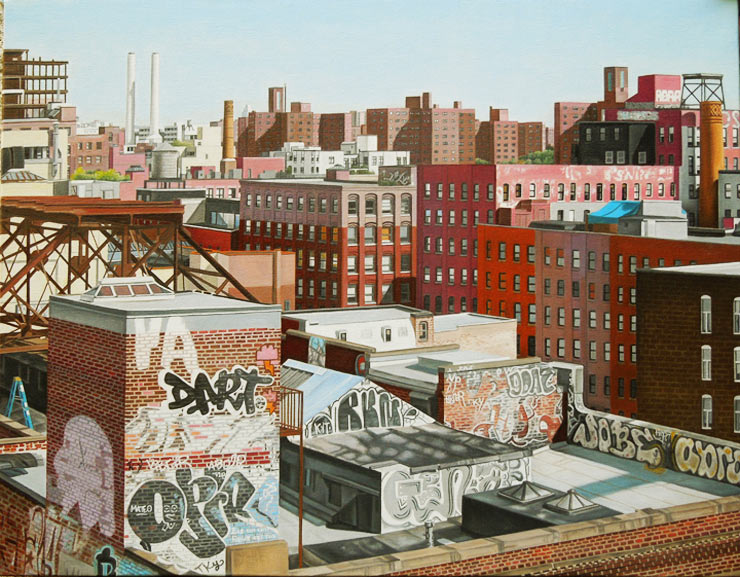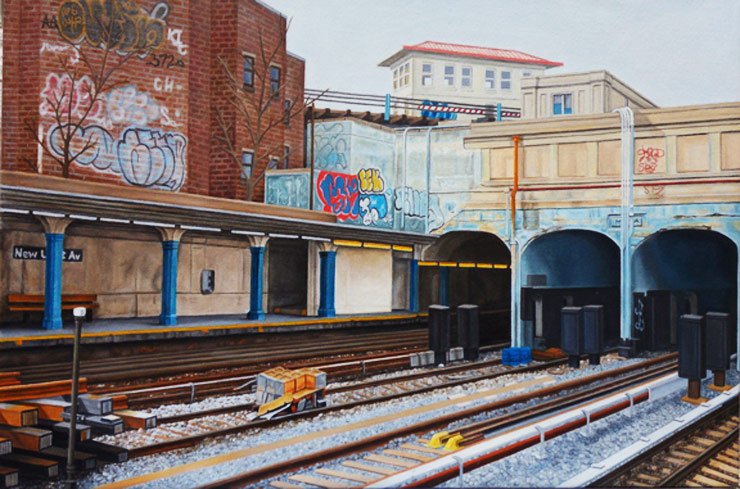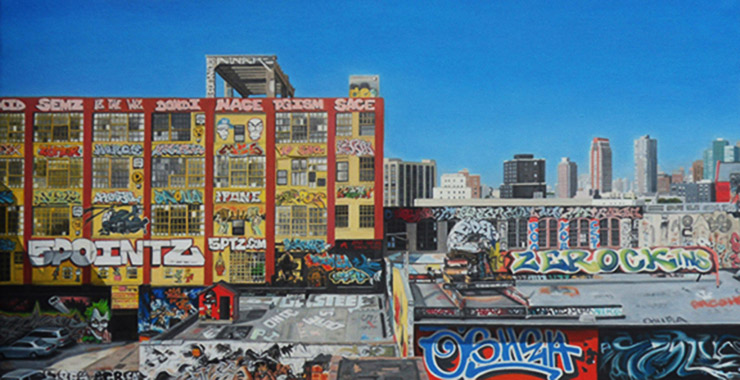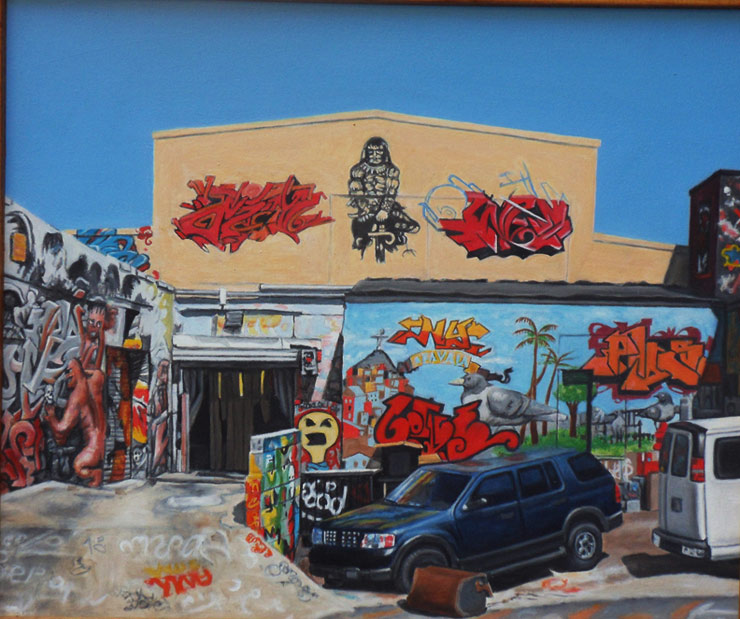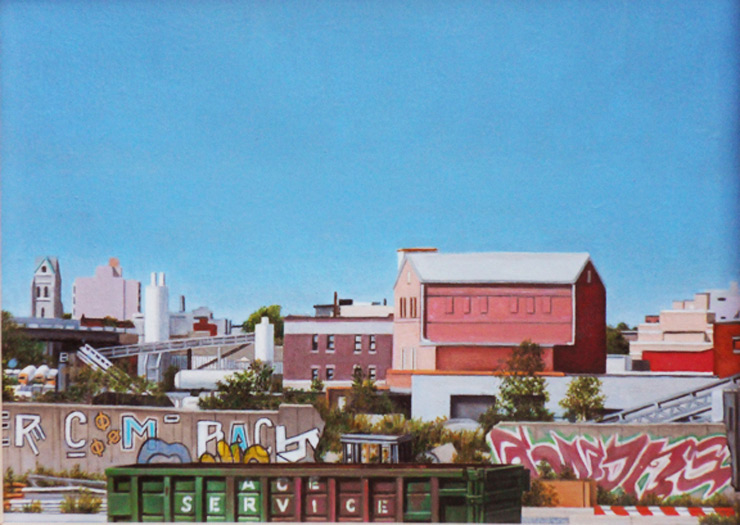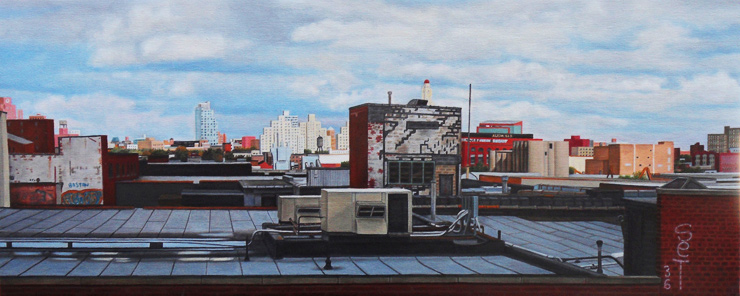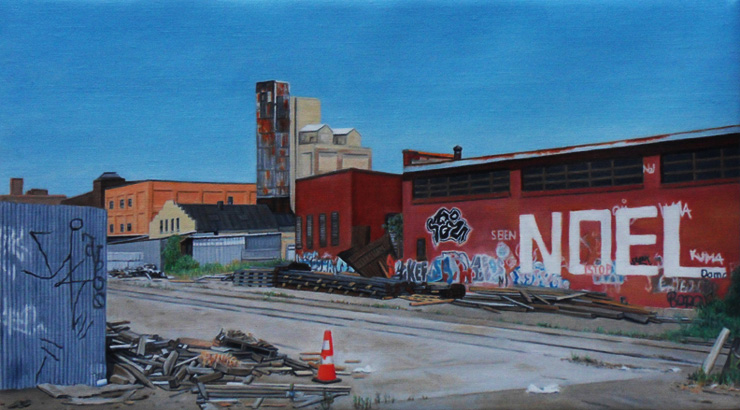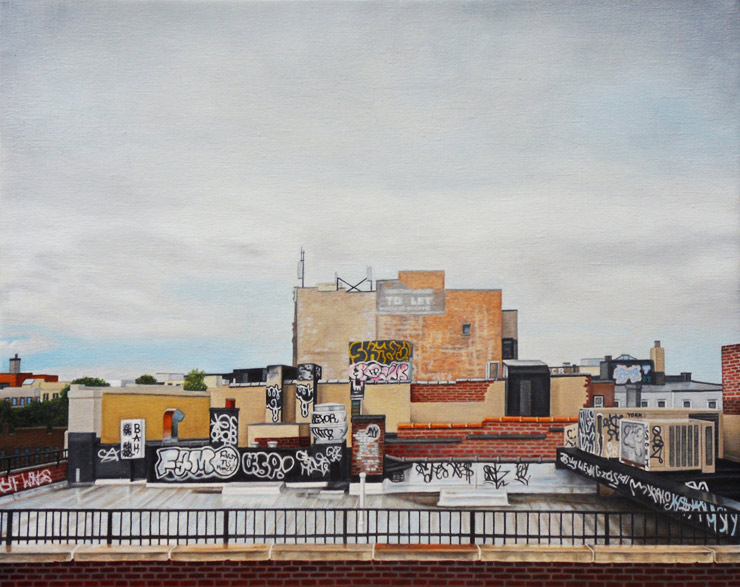If there is someone who knows Brooklyn Street Art and graffiti, it is Laura Shechter.
Dart, Cash4, Cost, Sace, City Kitty, Chris Stain, she knows them all.
And yet she doesn’t know them at all.
When you live in a city and see graffiti or Street Art the creators of the scene cannot hope to define everyone’s experience of their work. In fact, it is an entirely unique trip for each person.
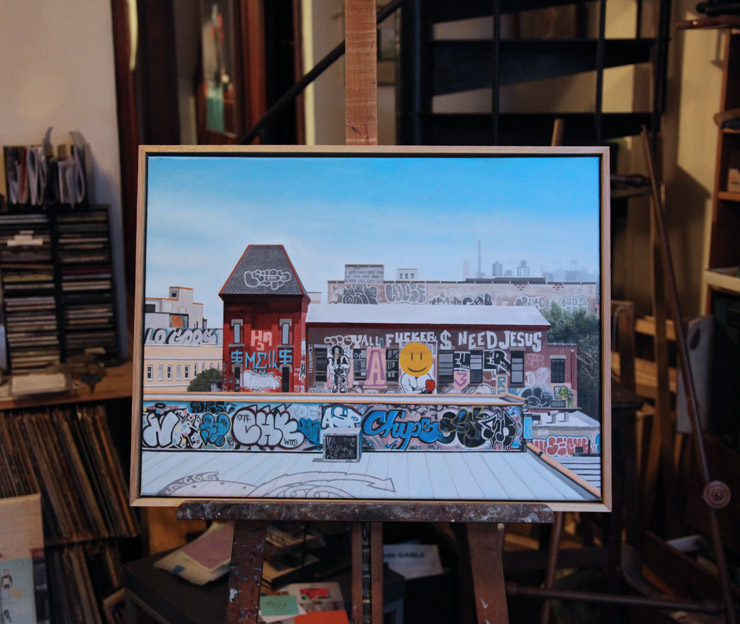
Laura Shechter (photo © Jaime Rojo)
If Laura Shechter happened to capture a graffiti tag or throwie or Street Art wheat-paste or stencil or sticker in one of her careful and precise photo-based cityscapes, she probably didn’t see it as you did, because she may not see her city in the same way you do. Ms. Shechter has spent hours with these pieces; recreating, rendering, and documenting by hand and brush the coded chaos and conversation on city walls. For this painter it is about supporting the craft of the artists of this time – much in the same way that she used her earlier still life painting to support the craft of hand painted china from the 19th century.
Others may see these graffiti works as indicators of blight, as eyesores, or signs of the decline of a block or neighborhood. For the majority it may be a visual noise that doesn’t register, let alone merit contemplation or documentation. Laura Shechter is placing this graffiti and Street Art front and center on her canvas, and the rougher the better.
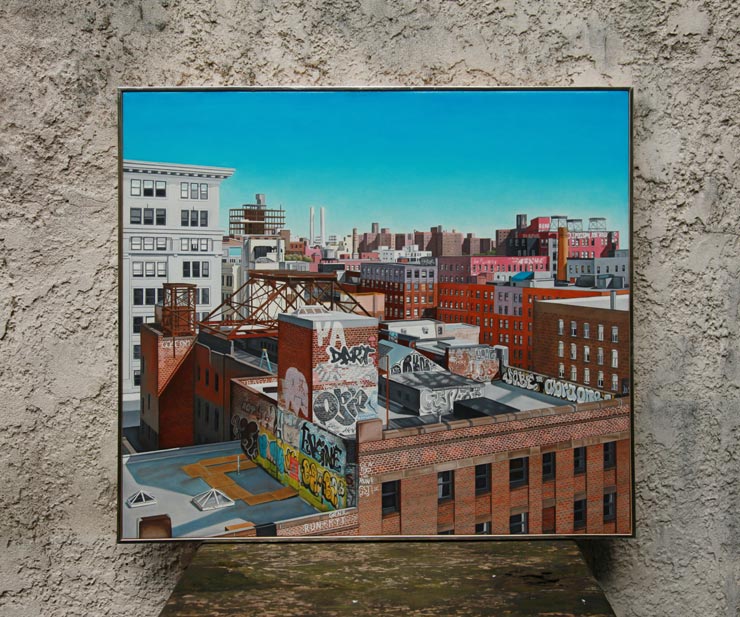
Laura Shechter (photo © Jaime Rojo)
She doesn’t always call it tagging; sometimes she calls it signing or a signature. The graffiti practice of “going over” someone else’s work as a sign of dismissal is called “over writing” in Schecter’s descriptions. She also sees graffiti as “beautification of urban blight.”
Separating the layers of paint and planes with her mind’s eye and layering opaque with transparent, she is perhaps more aware of the strata of pigment, hue, shade, tone, and technical history of a graffitied wall than she is of the vernacular and terminology of day-to-day graffiti and Street Art culture.
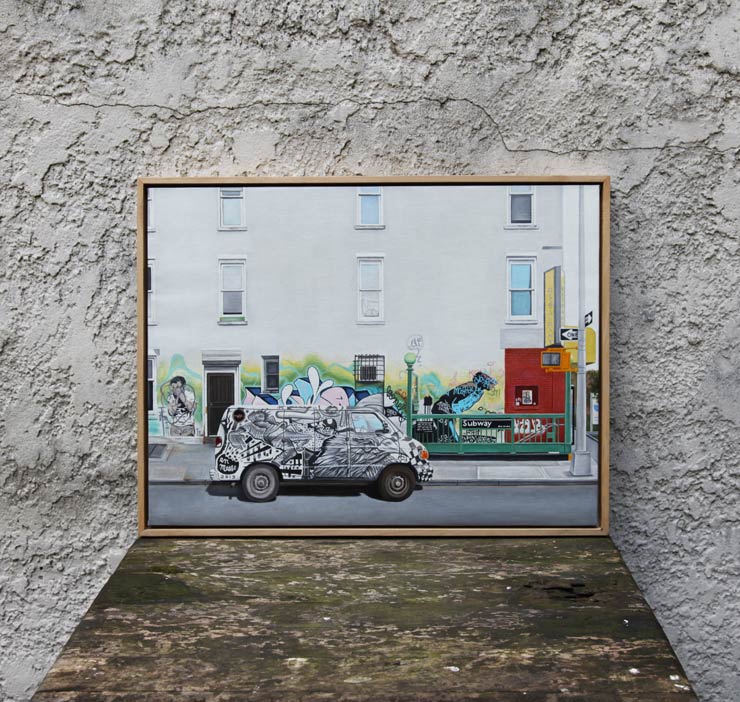
Laura Shechter (photo © Jaime Rojo)
Shechter discovered many of these scenes on walks or trespassing adventures with her artist husband Ben and she felt a connection to them, these aerosol tableaus, wanting to save them for posterity.
“I’m good at rendering because I have been a student of 10,000 years of art history,” she says. “I’m involved with technique, observing, and perception. I also understand what is underneath. When I’m rendering the graffiti I am also rendering the graffiti that is underneath it. I’m also sensitive to plane changes so I understand graffiti when it is fading out and when it is sharp.”
She talks about her attraction to this kind of work and perhaps her feeling that she has a connection to the people who practice it. “I was raised in Brownsville, Brooklyn and I am of the ghetto,” says the unpretentious artist who has spoken of a home life in the 1940s and 1950s that was characterized by poverty and very challenging circumstances.
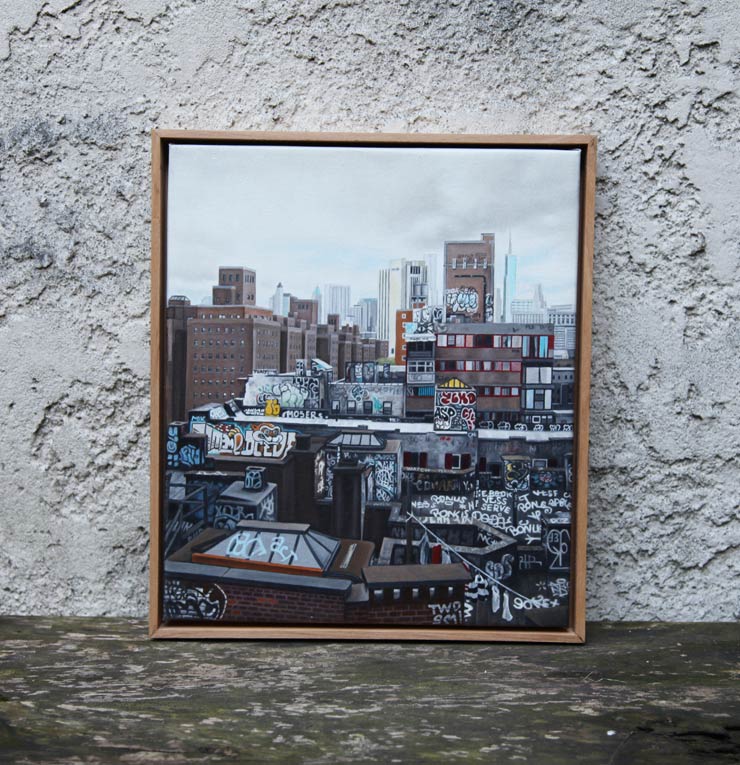
Laura Shechter (photo © Jaime Rojo)
“My work is rarely about the murals that are painted by those who went to art school. I was also a caseworker for the city and I walked most of the ghetto neighborhoods of NY. I am a really aware how ugly it was,” she says.
Today she’s concerned about what gentrification has done to similar neighborhoods and families. “I don’t know if there are any poor people left in Williamsburg. When you are going on a main shopping street on a Saturday, there’s almost nobody older than 30 years old. It almost becomes artificial and I would never want to live there. It would be an unpleasant place because it has become plastic,” she says.
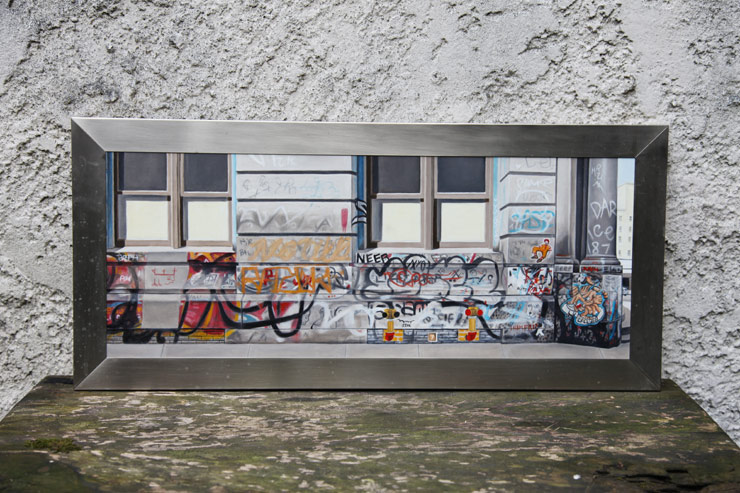
Laura Shechter (photo © Jaime Rojo)
To the painters’ eye these raucous graffiti walls are colors, textures, planes, gestures; gyrations and rhythms of the vibrating city, our history of cacophony distilled, the forceful and waning multi-accented assertions of the vox populi captured here on a wall. One can imagine that Shechter can hear very clearly some of those voices splashed and layered here.
A contemporary realist, Shechter studied at Brooklyn College with noted abstract painter and a father of minimalism, Ad Reinhardt, in the mid 1960s. She says she absorbed some of his minimalist techniques even with her still lifes in oil, watercolor, pencil, silverpoint, and lithographic prints. Here work developed into a career with gallery representation and a steadily growing collectors base over the next 35 years or so.
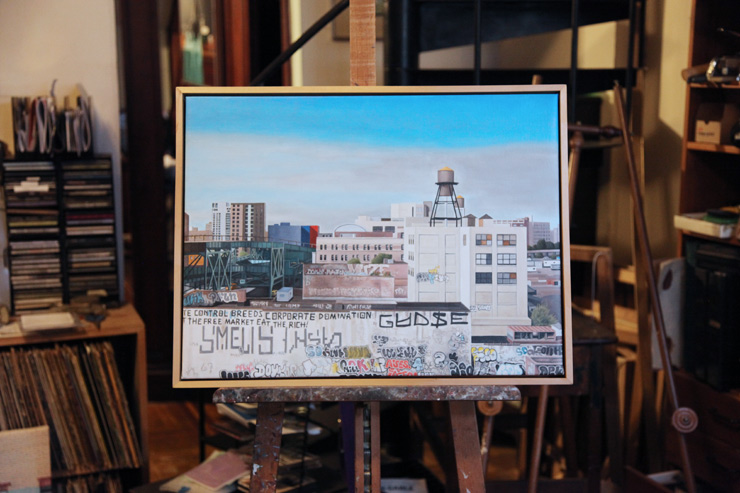
Laura Shechter (photo © Jaime Rojo)
Sometime in the late 1990s she says there was a crises in her work and she began thinking that she had explored still life painting and drawing completely, with no where left to go. In the early 2000s she grew interested in photo-based cityscapes through looking at and watching the art practice of her husband, who worked with his own photography as inspiration for his paintings.
In a speech given about her work last October at Mendez Soho in New York she spoke of her departure from still life painting and learning to paint cityscapes, sky, water – and how difficult it was to learn again. “It had to do with humility. The humility came from the idea of ‘how to deal with something that you are extremely competent in and then go back and become incompetent?’ ” She painted densely packed scenes of multileveled high-rises, seeing her city in a new way in terms of plains and horizontal lines and complexity.
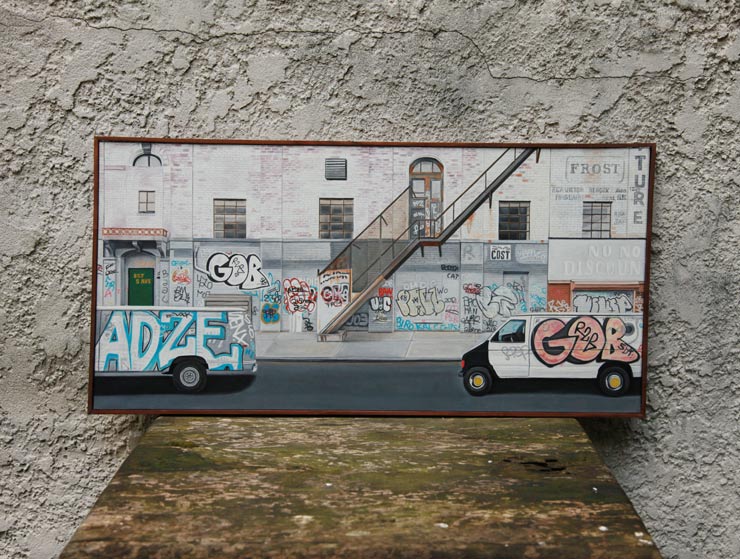
Laura Shechter (photo © Jaime Rojo)
Then one of her cityscapes that she captured while looking off the Williamsburg Bridge happened to contain graffiti “only by chance”. It was exhibited at the National Academy later and the curator of that show introduced Shechter to the graffiti haven in Queens called “5 Pointz” and she did a painting of the massive complex crushed in pieces, thowies, tags.
“Basically doing that painting changed the whole direction that my work was taking,” she says. A few years later in 2015 her body of graffiti cityscapes won her the NYFA Artist’s Fellowship from the Academy.
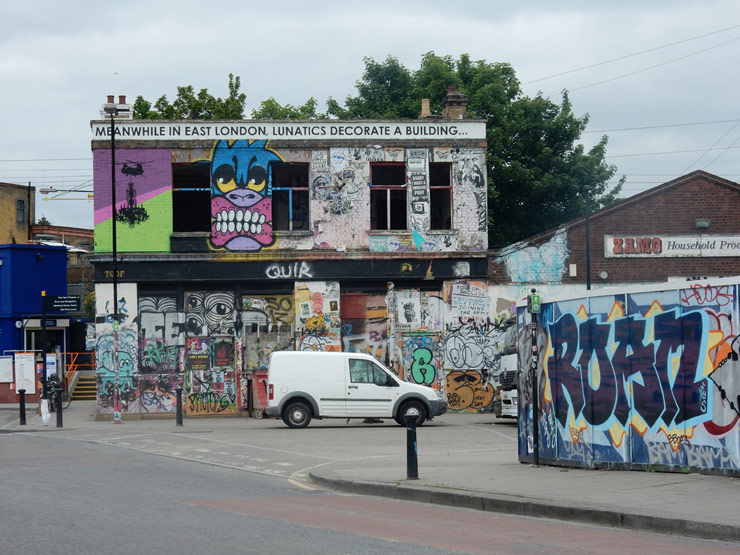
A photo to use as a painting study from Hackney, London. May 2017. (photo © Laura Shechter)
In 2016 her husband Ben passed away after nearly five decades together and their warm Park Slope Brownstone brims with the intermingling of the two artists styles and interests. She says it has been difficult to adjust to the loss, but she has been busying herself with projects. To seek new inspiration from the streets abroad she travelled to London this spring to see the vibrant graffiti, Street Art, and mural scene there and to shoot photos for reference in her next body of paintings.
Siting the many legal walls that she discovered, the bright poppy colors that are popular today, and a perceived lack of direct relationship to the struggles of low-income people, her Brooklyn pride may overshadow her appreciation of what she captured in another city.
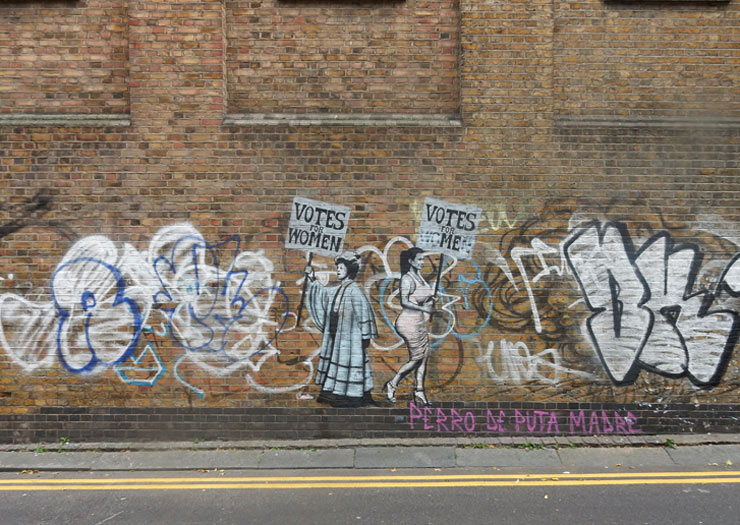
A photo to use as a painting study from Shoreditch, London. May 2017. (photo © Laura Shechter)
“Although London Street art is powerful, it lacks the finesse and craft of New York graffiti and it did not evolve naturally from the poorer neighborhoods,” she tells us. “Early New York graffiti writers had a limited palette of aerosol colors that tended to be intense.”

A photo to use as a painting study from Brick Lane, London. May 2017. (photo © Laura Shechter)
“They used natural arm movements that produced a more sensuous line and incorporated effects that result from the aerosol can; fuzzy edges, drips that add interest to the surface. London aerosol artists tend to fill in areas and their colors are the new tints and a heavy use of silver. Although there is some oversigning, they lack the beauty of layering of tags in New York graffiti, ” she says.

A photo to use as a painting study from Hackney, London. May 2017. (photo © Laura Shechter)
A teacher and lecturer at Parsons and the National Academy of Art, Schecter’s works are today included in several museum collections including Art Institute of Chicago, San Francisco Museum of Fine Art, and her hometown Brooklyn Museum where she prizes the feminist perspective which the institution champions, recalling her involvement since the 1970s as a member of both Women in the Arts and the Woman’s Caucus for Art. With such a rewarded career of professional accomplishment it is all the more interesting that the artist holds a certain reverence for the aesthetics of graffiti and Street Art.
But she is from Brooklyn after all.
Brooklyn Street Art: As an admirer of aesthetics, where do you find beauty in public spaces?
Laura Schecter: I enjoy walking the streets or riding a train and encountering sudden beauty when it is unexpected. Buildings used to be dirty brown, grey. I like simple doorways with 100 signatures…Especially graffiti on old brick and weathered wood, and the graffiti trucks are ever evolving and pure works of art.
I liked walking with Ben for miles and miles. Some photos he had to take because he was taller. I was always surprised how different our photos could be of the same spot. Sometimes I used his. I’ve been making home videos – one I made for him about him and his songs last summer and a personal one called “Brownsville Childhood.” That’s what you do when someone dies, you get projects.
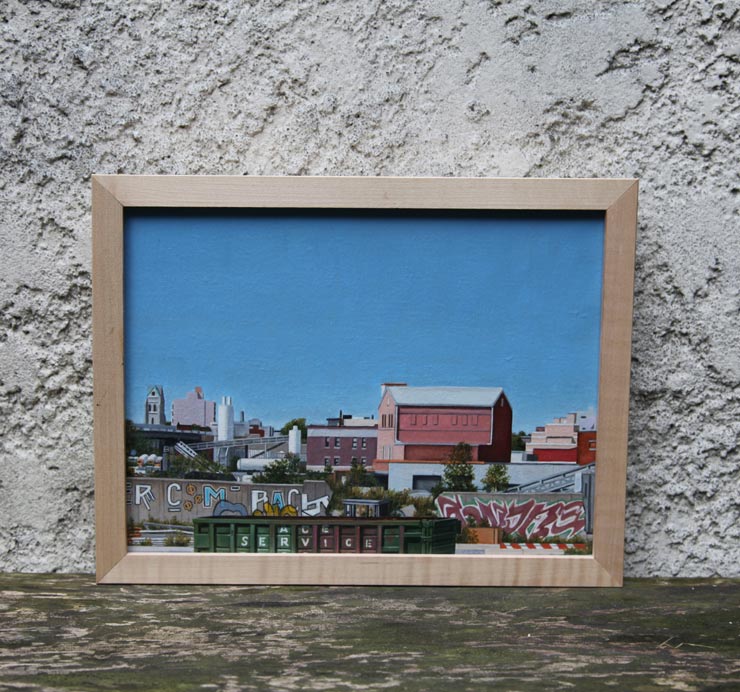
Laura Shechter (photo © Jaime Rojo)
Brooklyn Street Art: As a contemporary realist, what are you observing in the cityscape that others may be missing?
Laura Schecter: I was painting the still life and felt that I had nothing more to say about it. My husband Ben Shechter used photos and other sources in his own art work. I borrowed one of his photos that he shot from the “F” train looking into the Gowanus Canal. It was like jumping into the abyss.
It presented a new problem where I had to teach myself new skills and develop a point of view. That process took about six years. I exhibited a painting of Williamsburg with graffiti at the National Academy of Art and when I became friends with the curator Marshal Price, he told me about this place called 5 Pointz in Long Island City. The rest is history – I always tell him that this series of paintings is his fault.

Laura Shechter (photo © Jaime Rojo)
Brooklyn Street Art: What lead you in 2002 to begin painting and drawing photo-based cityscapes?
Laura Schecter: I have strong feelings about landscape space. A space that is created by having parallel horizontal bands. I have an innate sense of rhythm and patterns. I never have trouble with tedium, bring on all of those boring windows and bricks! I can now paint at ground level as I hone my vision.
I have overcome some of the drawbacks of photorealists (whose work can be mechanical) with my knowledge of 10,000 years of art and I can paint views that a painter on site misses, from being on moving trains and trespassing on roofs.
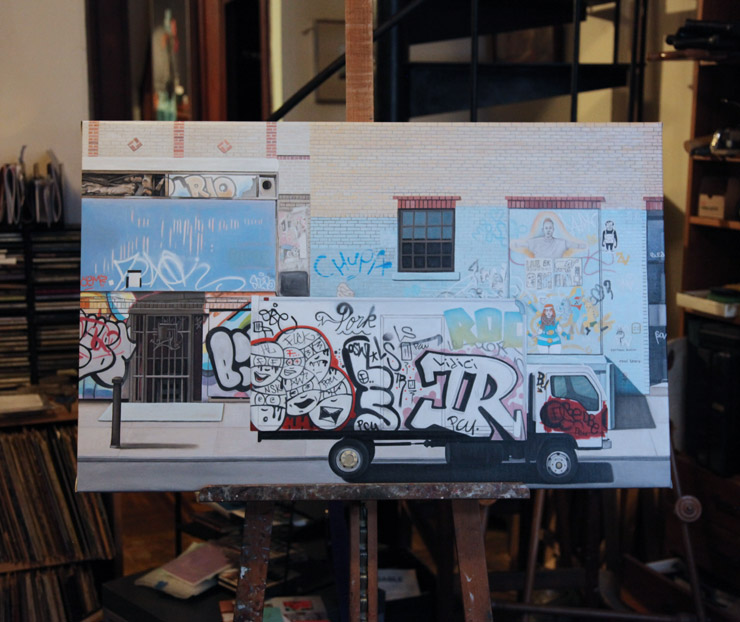
Laura Shechter (photo © Jaime Rojo)
Brooklyn Street Art: So you actually follow the Street Art scene?
Laura Schecter: Because I am constantly walking the 5 boroughs, I may revisit the same site once a year and see how it develops. I also visit centers of street mural art. And of course I read BSA every 2 weeks. This past May I spent an intense 6 days photographing graffiti in many sites and talking occasionally to young street Artists
Brooklyn Street Art: How would you describe how you approach graffiti and Street Art as an artist, as a person? When capturing graffiti and Street Art, is it about form and color and texture – or is it about culture and people and the visual conversation on the street?
Laura Schecter: I am most interested in graffiti walls that are well developed over time with over writing. In the beginning signing might have been random but later each tag was placed with intention, improving the general composition of the site.
What I like about earlyish graffiti was the limited color. Less is more. The graffiti writers maximized with these limited colors. I have gone to newer sites – one in south Bronx and the other in northern Queens where younger street artists are using pastel colors – For me it’s a little less than gritty.
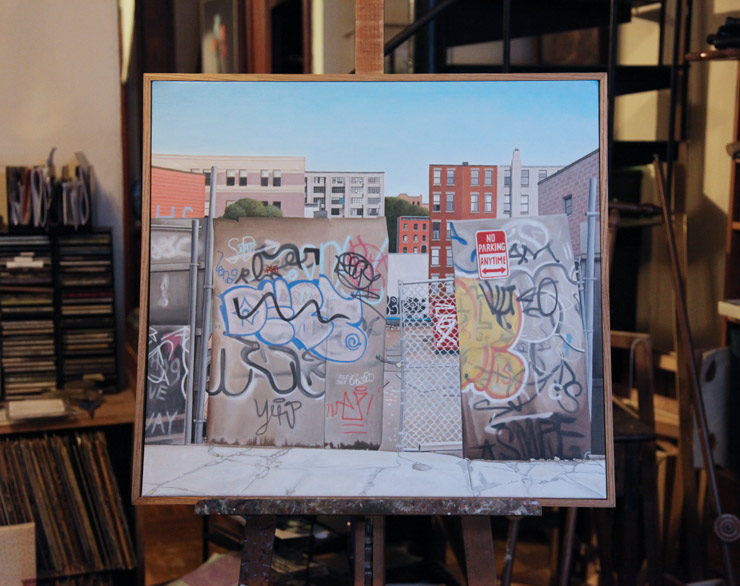
Laura Shechter (photo © Jaime Rojo)
This article is also published The Huffington Post

 BROOKLYN STREET ART LOVES YOU MORE EVERY DAY
BROOKLYN STREET ART LOVES YOU MORE EVERY DAY
